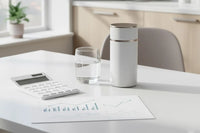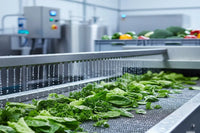Peracetic acid (PAA) has become the sanitizer of choice for many food processors looking to move beyond bleach and quats.
It’s powerful.
It’s approved.
It’s widely available.
But let’s be honest—it’s also a pain.
If your facility uses PAA, you’re already familiar with its drawbacks:
- That sharp, acidic smell that stings your nose
- The eye-watering PPE requirements
- The constant complaints from sanitation crews
- The corrosion on your stainless steel
- The overtime required to rinse and dry before restart
At some point, you’ve probably asked yourself:
“Is there a better way?”
The answer is yes.
It’s hypochlorous acid (HOCl)—and side-by-side, it doesn’t just beat PAA on safety and simplicity… it saves facilities thousands every month.
Let’s dive into the real-world cost, risk, and performance comparison of PAA vs HOCl—and why the smartest processors are making the switch now.
What Is PAA (Peracetic Acid)?
PAA is a blend of acetic acid (vinegar), hydrogen peroxide, and stabilizers. It kills microbes by aggressively oxidizing their membranes and proteins.
It’s powerful, yes—but also:
- Highly acidic (pH 1.8–2.8)
- Volatile and unstable
- Dangerous to inhale
- Corrosive to metals and surfaces
- Harsh on skin and mucous membranes
- Requires exact dilution and PPE
It must be stored in hazardous materials areas, monitored carefully, and always rinsed off food contact surfaces before use.
What Is HOCl?
HOCl is a naturally occurring antimicrobial created by human white blood cells. It’s generated on-site using water, salt, and electricity via an electrolysis process.
Unlike PAA, HOCl is:
- pH neutral (safe for all surfaces)
- Non-toxic, non-irritating, non-corrosive
- Leaves no chemical residue
- Requires no rinse
- Safe to spray, fog, or dip in occupied rooms
- EPA, FDA, USDA, NSF approved
- Cost-effective to produce in-house
Side-by-Side Comparison: HOCl vs PAA
| Attribute | HOCl | Peracetic Acid (PAA) |
|---|---|---|
| Kill Power | 99.999% (5-log) | 99.999% (5-log) |
| Rinse Required | ❌ No | ✅ Yes |
| PPE Requirement | ❌ None | ✅ Gloves, goggles, mask |
| Smell / Fumes | ❌ None | ✅ Strong acidic vapor |
| Storage & Handling | Safe, made on-site | Hazardous, requires special storage |
| Corrosion Risk | ❌ None | ✅ High on metals, seals |
| Worker Safety | ✅ Skin and eye safe | ❌ Skin and eye irritant |
| Organic Certified (NOP) | ✅ Yes | ✅ Yes |
| Shelf Life / Stability | Days (sealed container) | Hours (decays after dilution) |
| Cost per Gallon (Ready-to-Use) | $0.10–$0.20 | $1.25–$4.00 |
| Monthly Facility Spend | $300–$900 | $3,000–$12,000 |
The Financial Reality: HOCl Saves You Thousands
Let’s take a mid-size processor using 600 gallons of sanitizer per week.
PAA Cost: $2.50/gallon → $6,000/month
HOCl Cost: $0.15/gallon → $360/month
Savings: $5,640/month — not including:
- Reduced PPE costs
- Lower water bills from rinse elimination
- Reduced corrosion-related maintenance
- Less downtime from fogging + ventilation delays
- Fewer employee safety incidents and health complaints
Over a year? That’s $67,680 saved from switching to HOCl.
What Facilities Are Experiencing
🥩 Meat Processor in Kansas
Problem: Eye irritation and increased asthma complaints in sanitation crew using PAA. Constant replacement of corroded belt rollers and drain parts.
Switch: Installed Eco Max HOCl generator with fogging units.
Result:
- Respiratory complaints dropped to zero
- $11,000 saved in stainless steel part replacements
- Rinse cycle eliminated from SOP
- $7,400/month chemical cost savings
🐟 Seafood Facility in New Jersey
Problem: PAA fogging required full room evacuation for 45 minutes post-spray. Delays in shift startup and costly overtime.
Switch: Replaced with HOCl fogging system during lights-off hours.
Result:
- Fogging completed while room is occupied
- No PPE needed
- No downtime
- Saved $18,000/quarter in labor and lost production
🧃 Beverage Plant in Oregon
Problem: Lab results showed inconsistent kill rates with diluted PAA. Sanitizer barrels expiring too quickly.
Switch: On-site HOCl generation, with ppm monitoring for consistency.
Result:
- Improved swab scores across three lines
- Eliminated need for outside chemical delivery
- ROI in less than 2.5 months
Regulatory Status
Both HOCl and PAA are:
- ✅ USDA Organic certified
- ✅ FDA GRAS for food contact
- ✅ EPA registered for List K disinfection
But only HOCl is:
- NSF D2 certified (no rinse)
- Safe to use in fogging in occupied rooms
- Non-corrosive to sensitive surfaces
- Safe on skin and mucosa
Final Word: Same Kill. 90% Less Cost. Zero Compromise.
If you’re using PAA, you’re already halfway there.
You’ve made the move beyond bleach and quats.
You care about audit readiness, environmental sustainability, and kill power.
Now it’s time to finish the upgrade.
Because with HOCl, you don’t just eliminate pathogens.
You eliminate:
- Worker risk
- Eye-burning fog
- Lost hours to rinse cycles
- Soaring chemical bills
- Corroded valves and tank seals
You get purity, power, and protection—without poison.





